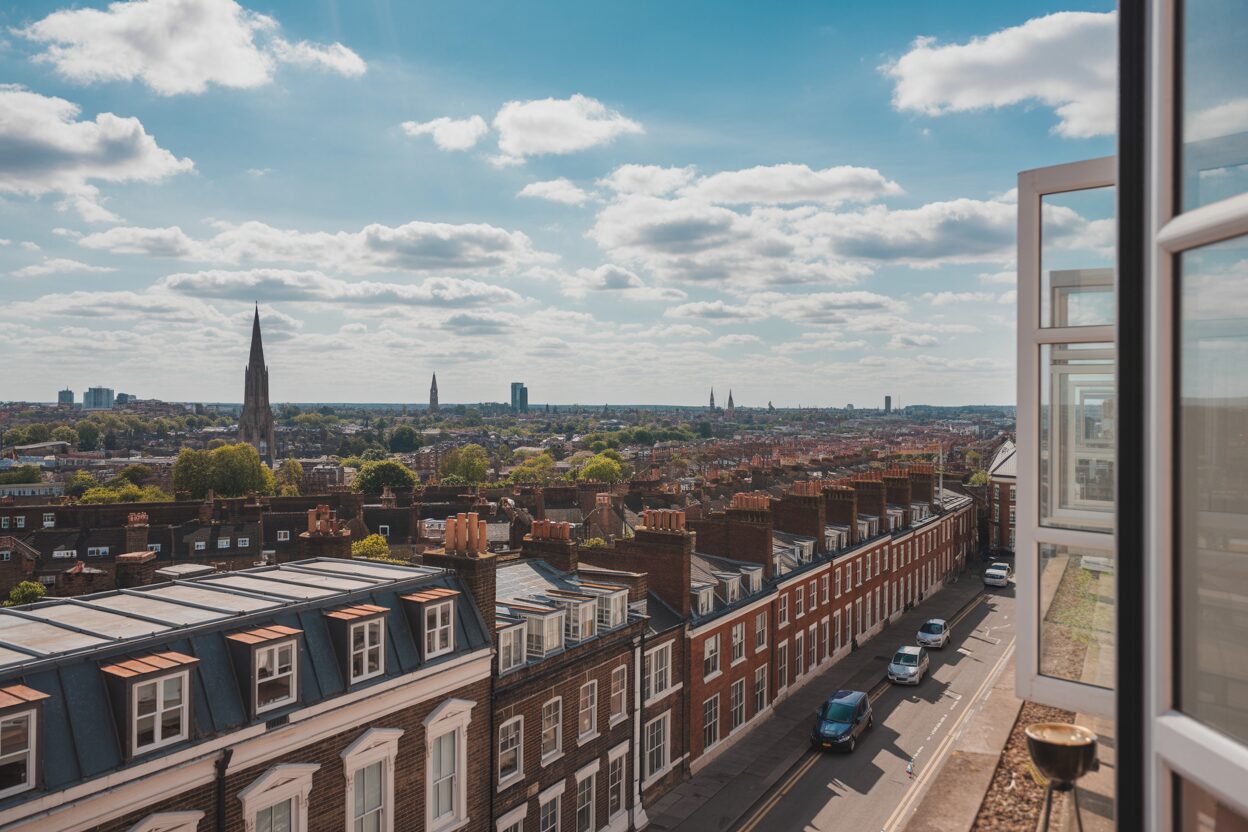
With average HMO yields at up to 12.5%, holiday lets at up to 7% and buy-to-lets at up to 5.8%, property offers investors proven wealth- and passive income-building opportunities. To get into the market, most developers, especially newer developers, need access to external finance. One popular route is bridging loans for property development.
In this article, learn what a bridging loan for property developers is and how one works. Discover the three main types of bridging loan available and how to improve your chances of getting into property investment.
What is a bridging loan?
A bridging loan is a form of short-term loan secured on your assets or your business’s assets.
In most cases, those assets are residential, commercial or mixed-use property. In other cases, lenders may also take commercial assets like accounts receivables, inventory and equipment. Generally, you have up to 24 months to repay a bridging loan.
Instead of making monthly payments, you repay in one lump sum at the end of the term.
How are bridging loans used in property development?
Investors use bridging loans to buy property they want to develop in situations where they need quick access to cash.
One popular use case is buying property at auctions. You can arrange a bridging loan much faster than a mortgage. For example, you can get a lender to agree to a bridge loan in a few days whereas mortgages can take up to three months.
Important bridging loan terms
Before we explain the different types of bridging loan for property developers, it’s important to know the terminology. This is not just for improving the quality of your loan application but it helps you understand how much money you need and if your project is viable.
Here are nine key terms in property development & bridging finance:
- Loan to value: The percentage of a property’s current value a lender will advance you
- Gross development value (GDV): How much your property will be worth after you’ve finished the project
- Loan to GDV: The percentage of a property’s expected value after you’ve developed it that you can borrow from a lender
- Loan to cost: The percentage of project costs a lender will fund. This always covers build costs and often includes the land or purchase price too. Some lenders also include contingency budgets and selected fees but check their policies.
- Staged drawdowns: On some types of bridging loans, you don’t get all the money at once. Instead, you receive it in tranches in arrears. The lender transfers each tranche once an Independent Monitoring Surveyor (IMS) checks and signs off on site progress.
- Rolled-up interest: You pay interest on top of the amount you borrow when you repay the loan. So, if you borrow £500,000 and the interest is £50,000, you repay a total of £550,000.
- Retained interest: Your lender deducts interest when you take out your loan. So, if you borrow £500,000, your lender deducts the interest at source, so you receive £450,000. You repay a total of £500,000.
- Simple interest: Simple interest is interest charged on the loan amount. So, if you borrow £500,000 at 1% a month for 12 months, you pay £560,000 in total.
- Compounded interest: Compounded interest is when your lender charges you interest. They then charge interest on that bigger balance the next month, so the total cost is higher. So, if you borrow £500,000 at 1% a month for 12 months, you pay £563,412.52 in total.
- Open bridging loan: Open loans have no fixed repayment date but many lenders expect repayment within the maximum term.
- Closed bridging loan: Closed loans have a set repayment date.
What types of bridging loans are available for property developers?
There are three main types of bridging loans available for property developers. They are standard bridging loans, light refurb bridging loans and heavy refurb bridging loans.
Standard loans are suitable if you want to buy a development property. If you want to buy a development property and need extra capital to renovate or convert it, choose a light or heavy refurb bridging loan.
You can use bridging loans to buy land or property that would be ineligible for a mortgage. For example, derelict buildings, properties with no working kitchen or bathroom, and land without planning permission.
Let’s look at the three types of bridging loans and how they differ.
What is a bridging loan for property development?
A bridging loan for property development is a short-term, secured financial facility investors use to buy property.
Lenders may offer up to 75% LTV meaning that you could borrow £300,000 on a property with £400,000. That means you’d need £100,000 of your own money to complete the purchase.
If you want to renovate, convert or alter a property, lenders will not provide the funding for this on a standard bridging loan. Instead, apply for a light or heavy refurb bridging loan.
Key information:
- Loan length: Up to 24 months
- Type of interest: Rolled-up and retained
- Maximum lending: 75% of the current property value
- Staged drawdowns: No
What is a light refurbishment bridging loan?
A light refurbishment bridging loan is a short-term, secured loan investors use to buy and refurbish property.
You can borrow up to 75% of the cost of the property and up to 100% of the build cost. You receive tranches of the build cost loan in arrears after an independent monitoring surveyor signs off each stage of your work on site.
The type of renovation work light refurbishment bridging loans are suitable for include:
- Painting and decorating
- Updating fixtures and fittings
- Installing new carpets or flooring
- Refreshing kitchens and bathrooms without a full refit
- Improving lighting and electrical fittings
- Minor plumbing repairs
- Repairing doors and windows
- Roof repairs without structural changes
- Adding insulation or upgrading heating
- Landscaping and external improvements
Light refurb bridge loans are not suitable for major structural alterations or property conversions.
Key information:
- Loan length: Up to 24 months
- Type of interest: Rolled-up and retained
- Maximum lending: 65% of the current property value and 100% of the build costs
- Staged drawdowns: Yes, on build costs
What is a heavy refurbishment bridging loan?
A heavy refurbishment bridge loan is a short-term secured loan used to buy and redevelop or convert land or property.
Lenders will advance up to 65% of the cost of the land or property and up to 100% of the build costs. You don’t receive all the money for your build project in one go.
Instead, you receive portions of it once an independent monitoring surveyor reports that your project has achieved an agreed milestone.
The type of work suitable for a heavy refurbishment bridging loan includes:
- Full kitchen or bathroom refit
- Converting a house into an HMO
- Commercial to HMO conversion
- Converting a house into flats
- Changing planning use (e.g. commercial to residential)
- Loft or basement conversion for extra living space
- Structural alterations such as adding or removing walls
- Full electrical rewiring, new plumbing or heating systems
- Roof replacement or major structural repairs
- Large-scale external work such as new windows, doors or façade
- Foundation repairs or modifications
Key information:
- Loan length: Up to 24 months
- Type of interest: Rolled-up and retained
- Maximum lending: 65% of the current property value and 100% of the build costs
- Staged drawdowns: Yes, on build costs
How do you repay a bridging loan for property development?
You repay a bridging loan for property development in one go at the end of the term. This is a single repayment of the amount you initially borrowed plus the interest you’ve built up.
Lenders don’t collect monthly payments when your project is underway to preserve your cash flow until you complete the project.
Ways to repay a bridging loan for property developers.
There are three standard “exit strategies”. An exit strategy is how property developers repay their bridging loans.
One option is to sell the property and repay the loan from the proceeds.
Another is to repay using a buy-to-let mortgage. You keep the property and rent it out to domestic or commercial tenants to generate an income.
The third is to repay it with a standard residential or commercial mortgage. You can then either live in or trade from the property.
If you’re not able to complete the work in time, your options include:
- Asking for an extension: Some lenders allow an extension, although you may have to pay higher fees and interest.
- Refinancing with another lender: Switch to a new bridging provider. The new lender may only do so if you have made a lot of progress on your development project.
- Converting to a development loan: Move to development finance to release further funds and give you more time to complete your project. As with a bridging loan, you’ll receive funding in tranches following site inspection.
What security does a lender need for a bridging loan?
Lenders accept the property or land you’re buying with a bridging loan as security. They prefer to have a first charge over the asset. Many accept second charges and some may accept third charges, but expect a lower LTV and to pay more in interest.
Bear in mind that if you miss your repayment date, they can repossess and sell the property to recover their money.
Do 100% bridging loans exist?
100% bridging loans exist but you have to offer additional security to your lender. For example, the highest LTV possible on most bridging loans for property development is 70-75%.
If you have other assets you can offer as security like a buy-to-let property that has enough equity in it, you may be able to get a 100% bridging loan.
Remember though that if you fail to repay your bridging loan, the lender may repossess both the property you bought and the other property you provided as security.
Can I access bridging loans as a new property developer?
You can access bridging loans as a new property developer. But, for your first few applications, expect a tougher approval process and to pay more in interest than an experienced developer.
The bridging loan market is competitive though so if your plan is strong enough, you should be able to find a lender or intermediary that can help.
To give yourself the best chance of a lender saying yes when you submit your application, focus on these three things:
- A strong business plan: Explain everything you’re going to do on your project right up to completion. Set out all the costs and have a contingency fund ready. Planning permission certificates and Schedule of Works timetables can be very persuasive.
- An exit strategy timetable: Show how you’ll repay the loan at the end of the term. If you’re selling, include comparables to prove your forecast sale price is realistic. If you plan to rent, include letting agent valuations and a mortgage-in-principle agreement if you have one.
- A professional team: Reduce perceived risk by surrounding yourself with industry experts. Name the architects, surveyors and builders you’re working with. This should satisfy a lender that you can deliver the project on time and to the highest standards.
HMO Architects: working with new property developers to find finance
With all bridging loans, lenders carry out strict due diligence on borrowers and set tough criteria on completion to control their exposure to risk. They approve loans based on your project’s viability and the credibility of your exit strategy.
HMO Architects has assisted over 750 property investors and developers, including many first-timers. Use our experience, knowledge and connections to break into property development.
Recent examples of the projects we’ve worked on include:
- Kilburn High Road, London (8 units): This is a grand townhouse whose developer wanted to retain its elegance and convert it into a high-standard HMO for professionals and students. This is the type of heavy-refurb scheme that, with the right team, lenders are willing to back. The work increased the value of the property from £1.2m to £1.8m and the rent from £6,000pcm to £11,200.
- Mill Street, Birmingham (11 units): This was a complex job turning a former retail and office building with varying heights and mixed materials into a cohesive collection of 11 self-contained, one and two-bedroom flats. We later added in a shared workspace to add further to the property’s appeal. The building value soared from £800,000 to £2.6m and the achieved rent went from £5,000pcm to £18,000.
- Devonshire Road, East Sussex (22 units): Working for a charity, this heavy-refurb saw the total remodelling of a former NatWest bank into a mixed-use asset with 22 HMO rooms for a veterans’ charity plus offices. The charity benefited from the uplift in the value of the property to £1.32m (from £500,000) and monthly rent from £4,500 to £11,000.
You benefit from these services all in one place:
- Investment strategy call: Get tailored advice on how to build and scale your property portfolio.
- Feasibility call: Your idea might look good on paper but get us to run a thorough check and produce a detailed report both pre-buy and on design potential.
- Planning permission: We’ve worked with over 200 councils to secure consent for our clients.
- Interior design and exterior architecture: Let our architects value engineer your project so it appeals to your target market while keeping costs down. Maximise your yield and minimise your expenditure.
- On-site management: We can represent you as your Building Regulations Principal Designer (where required) so you stay compliant.
- A wider network: Let us introduce you to property finance professionals and a range of other industry experts, including building contractors and planning consultants.
Ryan Windsor, our co-founder, will oversee your project and the team working on it. Ryan has been in property since he was 17, has grown an extensive property portfolio and has worked on over 2,200 projects. If you’re interested in HMOs, ask him about HMO project financing and how it works.
View our range of development finance case studies to see how we’ve helped clients turn their ideas into sound investments. Read customer stories on HMO, flat, holiday let and housing projects.
Call our experienced team on 01223 776 997 or email us.
Frequently asked questions
Bridging loans vs refurbishment mortgages
You can use bridging loans or refurbishment mortgages to finance property refurbishment projects.
Bridging loans are better for short-term, fast refurbishment projects where your aim is to get in and get the work done fast. A refurbishment mortgage is a much longer-term loan similar to a self-build mortgage. In both, lenders release funds to you in stages depending on build progress.
Some refurbishment mortgages require you to show that you have the funds and borrowing capacity to cover the cost of the works. That makes them harder to obtain than bridging loans.
Can you only get bridging loans on residential property?
You can get bridging loans on residential, commercial and mixed-use property. For example, if you see a retail or industrial unit you want to purchase, apply for a commercial bridging loan for property development.
Development bridging finance is also available on mixed-use property. So you can buy and develop buildings that, for example, have a shop on the ground floor and flats above.
Light refurbishment bridge loans vs heavy refurbishment bridge loans
Lenders usually ask you to provide detailed costs for refurbishment projects when you apply.
You can normally carry out light refurbishment without planning permission, such as replacing kitchens.
Heavy refurbishment means making structural changes to a property, and these works usually need planning consent and Building Control approval.
Ryan Windsor, Development Director and co-founder of HMO Architect, brings over 15 years of specialised experience in HMO development to the table. Having consulted on nearly 2,200 projects, Ryan is a highly seasoned HMO landlord with a vast and influential property network. He began his real estate journey at just 17, rapidly amassing a wealth of experience that sets him apart in the industry. Beyond his professional successes, Ryan is passionately dedicated to giving back, leading numerous charitable initiatives that make a meaningful impact on local communities.




